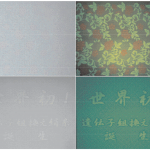biomaterials
There was some big news yesterday in transgenic silk from Notre Dame and the University of Wyoming, where scientists have genetically engineered silkworms to produce silk that is a mixture of spider silk and the regular silkworm stuff. Silkworms produce the strong and versatile silk that is used to make clothes, but spiders produce silk that can be much stronger and much more elastic. Spiders, however, don't like to be grown in huge factories and don't make easily harvested cocoons like silkworms, so gathering even small amounts is very difficult (here's a fun how-to for collecting spider…
I don't usually like to post links from BoingBoing because I imagine everyone has already seen this already, but as it is about some of my favorite things (synthetic biology, biomaterials, and fashion) I couldn't resist!
Designer Suzanne Lee makes clothes using cellulose-based fabrics made entirely by cultures of yeast and bacteria. From what I could understand from the ecouterre article, the process is similar to how kombucha is made, using the microbes to ferment a green tea mixture, although I thought that the film that forms on top of the fermenting tea in kombucha is some sort of yeast/…
Silk is an amazing biomaterial, cultivated and prized for more than 5,000 years. The silk threads that we weave into our shiny fabrics are actually enormous protein crystals produced by insects. This industrial silk that you can buy at the mall is made by silkworms, which use the silk to form the cocoon that protects them as they transform into moths. Many other species of insect also produce silk proteins to protect themselves or their eggs, get around, or catch their prey, but none in such enormous quantity in such easy to harvest packages as the silkworm. Silks from different species are…
Silks are incredible protein fibers produced by many different species of insects. Besides their use in making versatile textiles, silks are currently used in many different medical and engineering applications, from sutures to tissue engineering scaffolds to flexible electrode brain implants. Since I love fabrics and I'm interested in what biological engineers can do with biomaterials, I recently started working on a fun side project to raise and engineer silkworms, the animals used in industrial silk production around the world. We're having a lot of fun learning about silk and how to raise…


